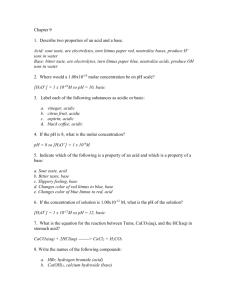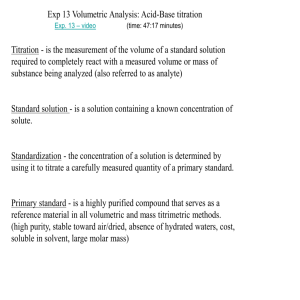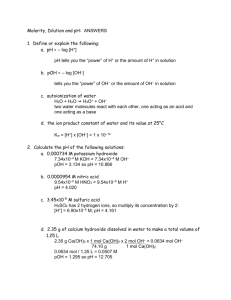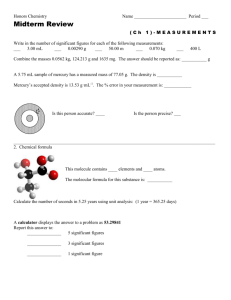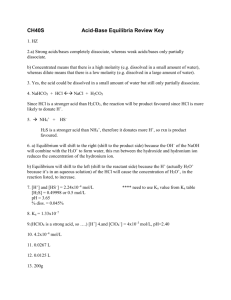solutions for simple pH problems and monoprotic acids
advertisement
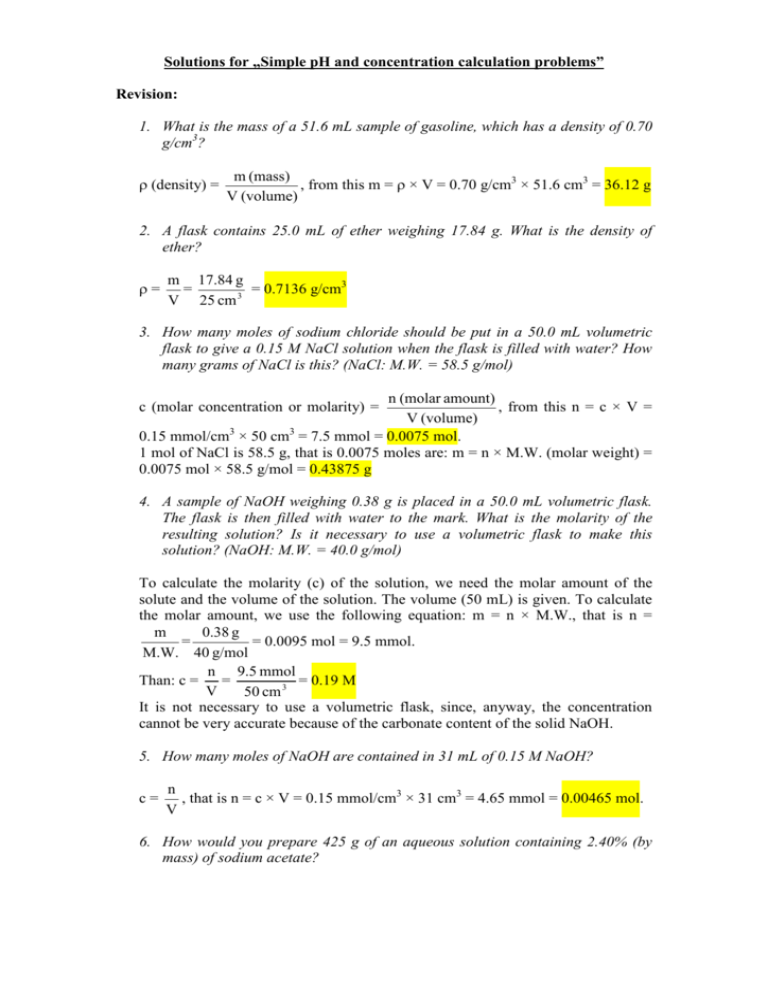
Solutions for „Simple pH and concentration calculation problems” Revision: 1. What is the mass of a 51.6 mL sample of gasoline, which has a density of 0.70 g/cm3? ρ (density) = m (mass) , from this m = ρ × V = 0.70 g/cm3 × 51.6 cm3 = 36.12 g V (volume) 2. A flask contains 25.0 mL of ether weighing 17.84 g. What is the density of ether? ρ= m 17.84 g = = 0.7136 g/cm3 3 V 25 cm 3. How many moles of sodium chloride should be put in a 50.0 mL volumetric flask to give a 0.15 M NaCl solution when the flask is filled with water? How many grams of NaCl is this? (NaCl: M.W. = 58.5 g/mol) n (molar amount) , from this n = c × V = V (volume) 0.15 mmol/cm3 × 50 cm3 = 7.5 mmol = 0.0075 mol. 1 mol of NaCl is 58.5 g, that is 0.0075 moles are: m = n × M.W. (molar weight) = 0.0075 mol × 58.5 g/mol = 0.43875 g c (molar concentration or molarity) = 4. A sample of NaOH weighing 0.38 g is placed in a 50.0 mL volumetric flask. The flask is then filled with water to the mark. What is the molarity of the resulting solution? Is it necessary to use a volumetric flask to make this solution? (NaOH: M.W. = 40.0 g/mol) To calculate the molarity (c) of the solution, we need the molar amount of the solute and the volume of the solution. The volume (50 mL) is given. To calculate the molar amount, we use the following equation: m = n × M.W., that is n = m 0.38 g = = 0.0095 mol = 9.5 mmol. M.W. 40 g/mol n 9.5 mmol Than: c = = = 0.19 M V 50 cm 3 It is not necessary to use a volumetric flask, since, anyway, the concentration cannot be very accurate because of the carbonate content of the solid NaOH. 5. How many moles of NaOH are contained in 31 mL of 0.15 M NaOH? c= n , that is n = c × V = 0.15 mmol/cm3 × 31 cm3 = 4.65 mmol = 0.00465 mol. V 6. How would you prepare 425 g of an aqueous solution containing 2.40% (by mass) of sodium acetate? The mass of sodium acetate needed is 2.40 % of the total mass that is 425 g 2.40 = 10.2 g of sodium acetate. The amount of water needed is the remaining × 100 mass that is 425 g – 10.2 g = 414.8 g of water. 7. You are given 5.00 mL of 14.8 M NH3 solution. What will the final volume be after this solution is diluted with water to give 1.00 M NH3 solution? To calculate the final volume of the solution, we need to know the molar amount of the solute and the concentration of the final solution. The final concentration (1.00 M) is given. The molar amount of NH3 is the same in the initial 5 mL and in the final solution, because we do not add any more NH3 during the dilution. Tis molar amount (calculted from the initial solution) is: n = c × V = 14.8 mmol/cm3 × 5 cm3 = 74 mmol = 0.074 mol NH3 Now, we know the concentration and also the molar amount of NH3 in the final solution, so we can calculate the volume of it: n n 74 mmol c= that is V = = = 74 cm3 = 74 mL 3 V c 1 mmol/cm 8. Commercially available concentrated hydrocloric acid is an aqueous solution containing 38% HCl by mass. It’s density is 1.19 g/mL. What is the molarity of this solution? How many milliliters of this concentrated solution is required to make 1.00 L of 0.10 M HCl solution? To calculate the molarity (c) of the solution, we need the molar amount of the solute (HCl) and the volume of the solution. Let’s take 1 mL of this solution (you can choose also a different volume). In this case, from the density of the solution, we can calculate the mass of the solution, which is: m = ρ × V = 1.19 g/mL × 1 mL = 1.19 g 38 38 % of this mass is HCl, that is the mass of HCl (solute) is 1.19 g × = 0.4522 100 g. So, the molar amount of HCl is: m 0.4522 g n= = = 0.0124 mol = 12.4 mmol. M.W. 36.5 g/mol Finally, the concentration of this solution is: n 12.4 mmol c= = = 12.4 M V 1 cm 3 If we want to make 1 L of 0.10 M HCl soluton, than we need the volumewhich contains the required amount of HCl. In the final solution we need: n = c × V = 0.1 M × 1 L = 0.1 mol of HCl. The same amount is needed in the concentrated solution, that is (for the concentrated solution): n 0.1 mol V= = = 0.0081 L = 8.1 mL of concentrated HCl solution. c 12.4 mol/L Simple pH calculations: 1. Calculate the pH of the solution: a) [H3O+] = 0.01 mol/dm3 b) [H3O+] = 4.1×10–3 mol/dm3 c) [H3O+] = 2.65×10–5 mol/dm3 a) pH = 2.00 b) pH = 2.39 c) pH = 4.58 2. Calculate the [H3O+] and the [OH–] concentrations in the following solutions: a) pH = 2.32 b) pH = 6.45 c) pH = 11.32 a) [H3O+] = 4.786 × 10–3 mol/dm3 b) [H3O+] = 3.548 × 10–7 mol/dm3 c) [H3O+] = 4.785 × 10–12 mol/dm3 [OH–] = 2.09 × 10–3 mol/dm3 [OH–] = 2.82 × 10–8 mol/dm3 [OH–] = 2.09 × 10–3 mol/dm3 3. A sample of orange juice has an equilibrium hydrogen ion concentration of 2.9×10-4 M. What is the pH? Is the solution acidic, basic or neutral? pH = -log[H+] = -log(2.9×10-4) = 3.54 pH < 7.00 so the solution is acidic. 4. A saturated solution of potassium hydroxide has an equilibrium hydroxide ion concentration of 0.05 M. What is the pH? Is the solution acidic, basic or neutral? pOH = -log[OH-] = -log(0.05) = 1.30 pH + pOH = 14.00 that is pH = 14.00 – pOH = 14.00 – 1.30 = 12.70 pH > 7.00 so the solution is basic. 5. A HClO4 solution has an analytical concentration of 0.012 M. What is the equilibrium hydrogen ion concentration and the pH? In the case of strong acids, the dissociation is 100 %, so the concentration of the acid and the H+ ion is the same (expect when cstrong acid < 10–6 M, but this is not our case). So, [H+] = cstrong acid = 0.012 M, and pH = -log[H+] = -log(0.012) = 1.92 6. A NaOH solution has an analytical concentration of 10-7 M. What is the equilibrium hydroxide ion concentration, the pOH and the pH? In the case of strong bases, the dissociation is 100 %, but now cstrong base < 10–6 M, so the selfdissociation of the water has also to be taken into account: KW [OH − ] = c strong base + [OH − ] [OH − ] = 10 −7 + 10 −14 [OH − ] [OH − ] 2 = 10 −7 [OH − ] + 10 −14 [OH − ] 2 − 10 −7 [OH − ] − 10 −14 = 0 − (−10 −7 ) ± (−10 −7 ) 2 − 4 × 1 × (−10 −14 ) [OH ] = =1.618 ×10-7 M 2 ×1 pOH = -log[OH-] = -log(1.618 ×10-7) = 6.79 pH + pOH = 14.00 that is pH = 14.00 – pOH = 14.00 – 6.79 = 7.21 - 7. Calculate the pH of pure water at 25.0 and 50.0 °C (KW = 1.0×10-14 and 5.0×10-14, respectively) In pure water there is no extra H+ or OH- so [H+] = [OH-]. At the same time so [H+] × [OH-] = KW. From these two equations: [H+] = K W At 25°C, [H+] = At 50°C, [H+] = 6.65 K W = 1.0 × 10 -14 = 1.0 ×10-7, so pH = -log(1.0 ×10-7) = 7.00 K W = 5.0 × 10 -14 = 2.236 ×10-7, so pH = -log(2.236 ×10-7) = 8. 10.00 ml of HCl of unknown concentration is titrated with potassium hydroxide whose concentration is 0.085 M. Calculate the pH at: a) 0 %; b) 40 %; c) 100 %; d) 160 % degree of titration. Up to the equivalence point 12.55 mL of KOH solution is consumed. a) 0% n(NaOH) = c × V = 0.085 × 0.01255 = 0.0010668 mol n(NaOH) = n(HCl) = 0.0010668 mol c(HCl) = 0.0010668 / 0.010 = 0.1067 M pH = -log[H+] pH = 0.9723 b) 40% 40% of HCl is titrated, 60% remains. n(HCl) = 0.6 × 0.001066 = 0.00064008 mol V(sol) = 0.010 + 0.00502 = 0.01502 dm3 n(NaOH) = 0.4 × 0.0010668 = 0.00042672 mol V(NaOH solution) = 0.00502 dm3 c(HCl) = 0.00064008 / 0.01502 = 0.04262 M pH = -log[H+] pH = 1.370 c) 100 % pH = 7.000 d) 160 % V(solution) = V(HCl sample) + V(NaOH eqiuv.) + V(NaOH extra) V(solution) = 0.010 + 0.01255 + 0.00753 = 0.03008 dm3 n(NaOH) = 0.00064008 mol c(NaOH) = 0.00064008 / 0.03008 = 0.02128 M pOH = -log[OH–] pOH = -log (0.02128) pOH = 1.672 pH = 14-1.672 = 12.328 9. 20.00 ml of HCl of 0.100 mol/dm3 concentration is titrated with sodium hydroxide whose concentration is 0.200 mol/dm3. Calculate the pH at: a) 0 %; b) 20 %; c) 50 %; d) 120 % degree of titration. a) 0 % c(HCl) = 0.100 mol/dm3 pH = - log [H+] pH = - log 0.1 pH = 1.000 b) 20 % n(HCl) = 0.80 × 0.002 = 0.0016 mol The amount of NaOH needed for the neutralization of 20 % of the acid: n(NaOH) = 0.20 × 0.002 = 0.0004 mol 0.0004 = 0.002 dm3 V(NaOH) = 0.200 V(solution) = V(HCl sample) + V(NaOH added to the system) V(solution) = 0.020 + 0.002 = 0.022 dm3 c(HCl) = n( HCl ) 0.0016 = = 0.07273 mol/dm3 V ( sol ) 0.022 pH = - log[H+] pH = - log 0.07273 pH = 1.140 c) 50 % n(HCl) = 0.50 × 0.002 = 0.001 mol The amount of NaOH needed for the neutralization of 50 % of the acid: n(NaOH) = 0.50 × 0.002 = 0.001 mol 0.001 = 0.005 dm3 0 .2 V(solution) = 0.020 + 0.005 = 0.025 dm3 V(NaOH) = c(HCl) = n( HCl ) 0.001 = = 0.04 mol/dm3 V ( sol ) 0.025 pH = - log[H+] pH = - log 0.04 pH = 1.398 d) 120 % After the equivalence point the pH of the solution is determined by the excess of NaOH. n(NaOH) = 0.020 × 0.100 × 1.20 = 0.0024 mol n(NaOH)excess = 0.0024 – 0.002 = 0.0004 mol V(NaOH) = 0.0024 = 0.012 dm3 0.200 V(solution) = 0.020 + 0.012 = 0.032 dm3 c(NaOH) = n( NaOH ) 0.0004 = = 0.0125 mol/dm3 V ( NaOH ) 0.032 pOH = - log [OH–] pOH = - log 0.0125 pOH = 1.903 pH = 14 – pH = 14 – 1.903 = 12.097

